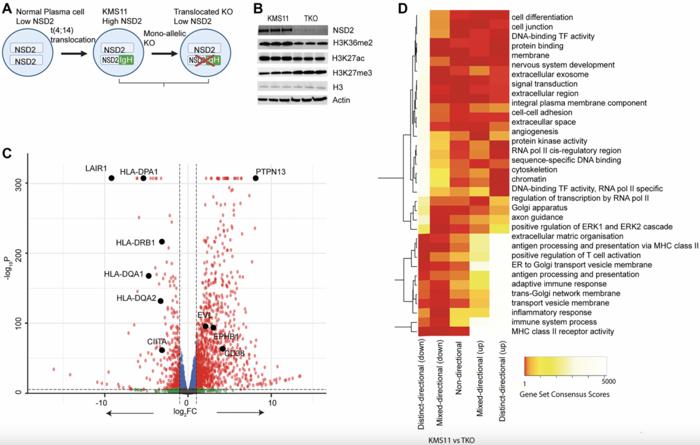A groundbreaking study has been published, shedding light on the role of the gene NSD2 in the context of multiple myeloma (MM), a type of blood cancer primarily affecting plasma cells. This research is led by a team from The Institute of Cancer Research in London, including Andrea Gunnell, Scott T. Kimber, Richard Houlston, and Martin Kaiser. The findings reveal critical insights into how NSD2 helps myeloma cells maintain their plasma cell identity, thus opening avenues for innovative therapeutic strategies aimed at this aggressive cancer variant known as t(4;14) myeloma.
Multiple myeloma is characterized by the malignant proliferation of plasma cells, which are responsible for producing antibodies essential for immune defense. Approximately 20% of patients diagnosed with this condition exhibit a chromosomal abnormality, specifically a translocation between chromosomes 4 and 14 (t(4;14)). This results in the overexpression of the NSD2 gene, which is crucial for understanding MM pathogenesis. The research focuses on comparing two distinct types of myeloma cells: one exhibiting high levels of NSD2 activity and another where this gene’s expression is inhibited.
The researchers found that the activation of NSD2 leads to notable biochemical changes within the cells. Through a process known as epigenomic reprogramming, NSD2 alters the structural conformation of DNA, impacting the gene expression profiles within the cells. This modification is pivotal as it governs how certain genes, especially those associated with plasma cell differentiation and functionality, are regulated. When NSD2 is active, the cells display traits typical of mature plasma cells, essential for effective immune responses. However, silencing this gene prompts the reactivation of previously dormant genes, indicating a regression in their plasma cell characteristics.
Significantly, the study describes how differential expression of key cell surface markers, like CD38, which is commonly associated with plasma cell identity, becomes altered when NSD2 functionality is compromised. The reduction in CD38 levels demonstrated by the NSD2-deficient cells suggests a loss of plasma cell identity, raising questions about the implications for treatment strategies. The research posits that targeting NSD2 could influence the responsiveness of myeloma cells to existing therapies that rely on CD38 as a target.
Furthermore, the physical morphology and functional assays performed by the research team revealed that cells with active NSD2 exhibit features that correspond more closely to fully differentiated plasma cells. In stark contrast, those lacking NSD2 appeared less mature and adopted characteristics indicative of immature or earlier-stage cells. This underscores the critical role NSD2 plays not merely in maintaining identity but also in the survival and proliferation of these cancerous cells.
The implications of this research extend beyond basic understanding. As novel pharmacological agents that specifically inhibit NSD2 are being developed, the findings suggest that their application could fundamentally alter treatment modalities for patients with t(4;14) myeloma. The modulation of NSD2 activity could lead to a cascade of effects on downstream genes resulting in changes in drug efficacy and cellular behavior.
This research also emphasizes the complexity of tumor biology, where a single gene can orchestrate vast networks of gene expression and cellular functions. Understanding the multifaceted role of NSD2 offers a platform for the development of more refined treatment approaches. This could be particularly beneficial for patients who do not respond to conventional therapies that target larger, more visible pathways but instead require a nuanced strategy that takes into account the subtleties of their cancer’s genetic profile.
As the field continues to evolve, the investigation into NSD2 and its effects on multiple myeloma presents an excellent opportunity to explore how targeted therapies can be developed. The aim would be not only to inhibit tumor growth but also to maintain or restore the identity and function of plasma cells, a delicate balance essential for healthy immune responses.
The insights gleaned from the study indicate a clear need for continuous research into the molecular underpinnings of cancer. By leveraging advances in genomic and epigenomic analyses, researchers can better delineate the pathways that contribute to malignancy and treatment resistance. This advancement opens the door for potentially transformative approaches in clinical settings, ultimately hoping to reduce the burden of multiple myeloma.
In summary, this research reinforces the vital role of NSD2 in maintaining plasma cell identity while elucidating the complexities of cancer biology. It provides a clearer picture of how targeting specific molecular pathways can revolutionize treatment protocols for high-risk myeloma patients and possibly transform standards of care globally. This study not only underscores the importance of NSD2 as a therapeutic target but also highlights the need for ongoing exploration of the genetic landscape in cancer therapeutics.
By fostering greater understanding of genetic factors in multiple myeloma, this research continues the critical dialogue between basic science and clinical application. The aspiration is clear: to harness scientific discoveries in ways that yield tangible benefits for patients struggling with this challenging and often aggressive form of cancer.
Subject of Research: Cells
Article Title: NSD2-epigenomic reprogramming and maintenance of plasma cell phenotype in t(4;14) myeloma
News Publication Date: 21-Mar-2025
Web References: https://www.oncotarget.com/
References: 10.18632/oncotarget.28706
Image Credits: Copyright © 2025 Gunnell et al.
Keywords: cancer, myeloma, NSD2, t(4;14), CD38, plasma cell




